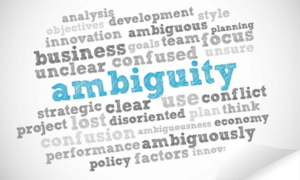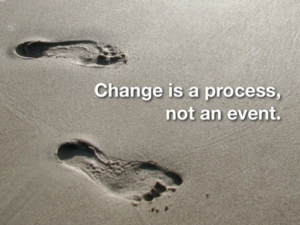Managing Rapid Change
Companies are being acquired, merged and reorganized at a rapid pace, creating workplaces that are filled with  ambiguities. The direction from prior leadership may contradict the direction given by new leadership. What may have worked yesterday may no longer be working today. Inside an environment of this kind, one of the most important skills any candidate can bring to the table is the ability to manage rapid change when the path is not clearly defined. It means that to stay on top of shifting conditions or to ensure you remain relevant throughout rapid change, you have to be flexible and responsive.
ambiguities. The direction from prior leadership may contradict the direction given by new leadership. What may have worked yesterday may no longer be working today. Inside an environment of this kind, one of the most important skills any candidate can bring to the table is the ability to manage rapid change when the path is not clearly defined. It means that to stay on top of shifting conditions or to ensure you remain relevant throughout rapid change, you have to be flexible and responsive.
Rapid change requires thinking in the moment and quickly assessing situations you may not have experienced before (and might not experience again). As a result of constant change, many jobs no longer follow prescribed SOPs but may only have a set of “guidelines.” Decisions may need to be made in short order and solutions implemented without exact instructions. It is important to be able to quickly recognize when new information is presented that may change how something will need to be carried out or when the objectives of those requesting an action have changed. For that reason, critical thinking skills are now fundamental requirements in many more work environments than ever before. Workers need to be able to quickly analyze new information objectively and make a reasoned judgment, based on past experiences and facts, versus expecting to always follow the same SOPs. Having enough knowledge and the experience to pivot correctly with a moment’s notice could be considered more valuable than having highly developed technical skills in some domains.
The ability to rapidly assess a situation and act quickly can be life-saving.
Using Agile methodology has been the norm in software development for many years. Its particular approach to project management assists teams in responding to the unpredictability of constructing software. The approach uses incremental, iterative work sequences to focus on process adaptability and customer satisfaction. This concept really applies to many other work environments that involve rapid change. If you are not meeting your customers’ needs, they can easily find another product or service that will. Sometimes it is necessary to go outside of SOPs and make split-second decisions to save an account or your company’s reputation, especially if you work in a highly competitive and visible arena. The ability to rapidly assess a situation and act quickly can (figuratively or literally) be life-saving. Imagine working in the emergency room or arriving at the scene of an accident. Hopefully, you wouldn’t take your scheduled break when four gurneys were rolled in or keep driving if there were people who needed help. Agile methodology can be applied to many processes that, by necessity, must change to keep up with what is going on in real time.
iterative work sequences to focus on process adaptability and customer satisfaction. This concept really applies to many other work environments that involve rapid change. If you are not meeting your customers’ needs, they can easily find another product or service that will. Sometimes it is necessary to go outside of SOPs and make split-second decisions to save an account or your company’s reputation, especially if you work in a highly competitive and visible arena. The ability to rapidly assess a situation and act quickly can (figuratively or literally) be life-saving. Imagine working in the emergency room or arriving at the scene of an accident. Hopefully, you wouldn’t take your scheduled break when four gurneys were rolled in or keep driving if there were people who needed help. Agile methodology can be applied to many processes that, by necessity, must change to keep up with what is going on in real time.
Change itself is a process that requires ongoing examination and assessment of the status quo to ensure that what is being offered remains relevant. This process applies to all types of product development and service delivery, whether it is for medical equipment, health care or producing safe tires for our cars. Consequently, it calls on employers and employees to act differently than they have in the past. If you are struggling because too many things are changing at once, you may want to employ these basic coping mechanisms:
Ask questions. Whether it is a customer request or a project assigned to you by your supervisor, make sure you are clear about the goal before you act. What is the purpose behind the request? Are you clear about what really needs to be accomplished and why? Change happens for a reason. Know why things need to be different.
Ask more questions. Do you have all the facts? Has anything changed since you were first assigned a project or task that could alter the outcome? Check with coworkers or peers in other departments to know what you may be missing before you dive in so you don’t risk getting carried away on a tangent.
Look for solutions. First and foremost: don’t whine. Look for answers. Instead of asking “what do you want me to do?” consider potential solutions and solve your problems. Be prepared to discuss your reasoning for each if you need to ask for input from your supervisor when deciding which course of action to select.
Stop performing busywork. Avoid spending time on tasks that no longer produce value. Understand the big picture enough to know when a regular activity no longer produces a benefit and recommend a change in procedure if necessary.
Pay attention. Look around at your environment and read the body language of those around you every day. Take note of changes in demeanor and postures. Read your company’s annual report or any related newsworthy events that have been published. The point is to stay on top of change as it happens and avoid being blindsided. Look out and forward, not down. Be aware of impending changes that could impact you down the road.
Probably the most important point is that the one constant about change is that it is here to stay. Over the decades, we have watched as productivity and high performance moved into the forefront and ultimately replaced loyalty or commitment as number one attributes for employees. Reliability stopped being enough and value became the focus. Over the past decade, we’ve watch that concept get ratcheted up a notch. Slow and steady have been replaced by nimble and resilient. Showing up on time and being able to follow SOPs are in less demand and the ability to adapt quickly when priorities change has become a necessity. Without it, you could find yourself left in the dust.





